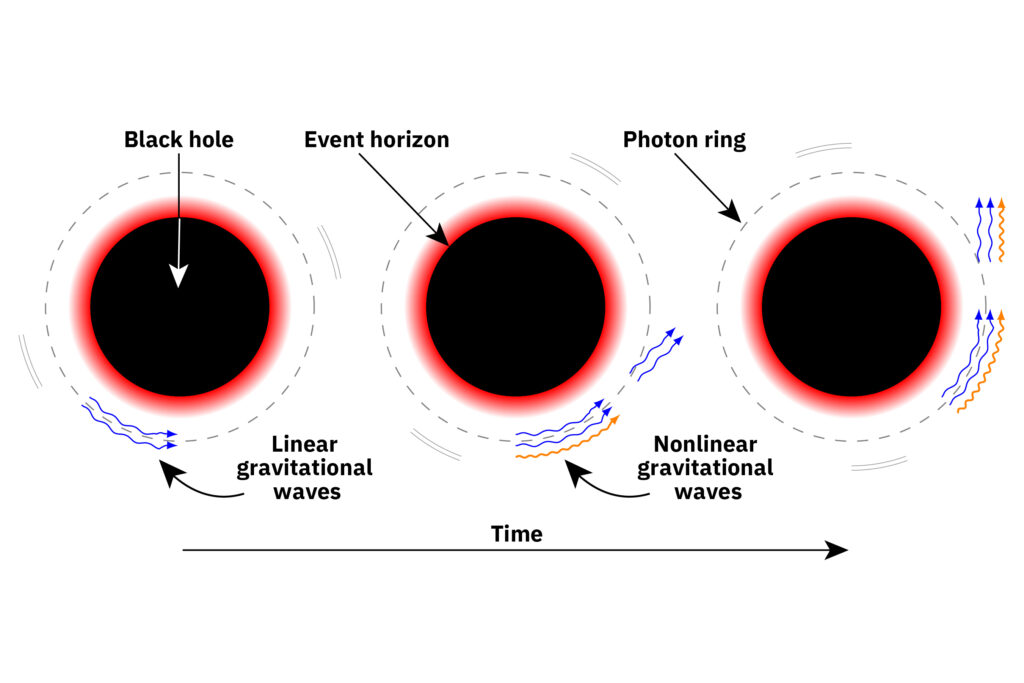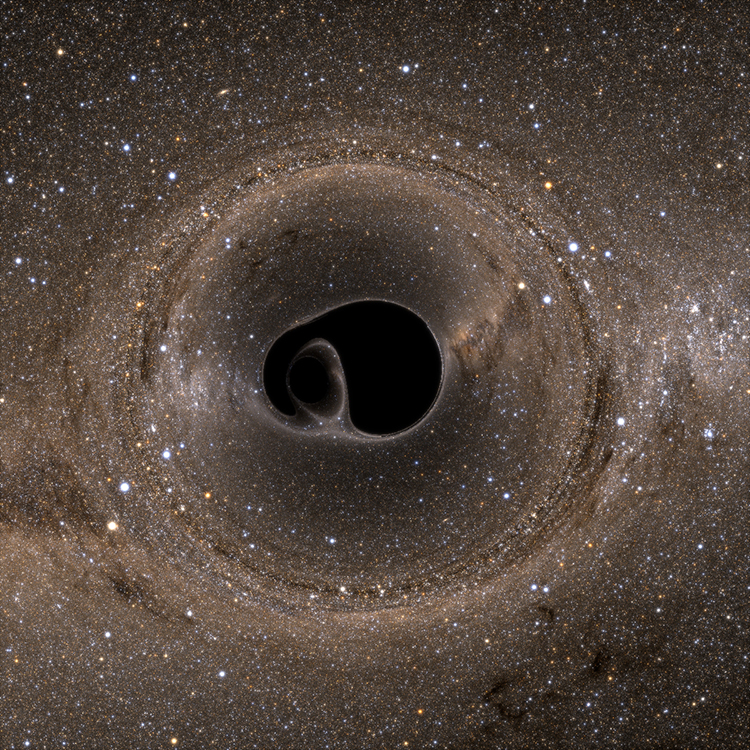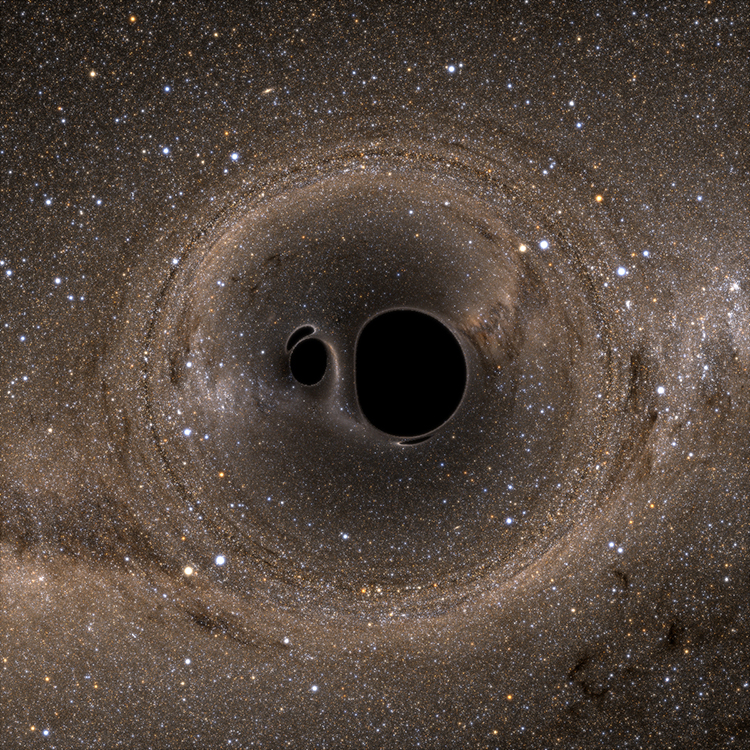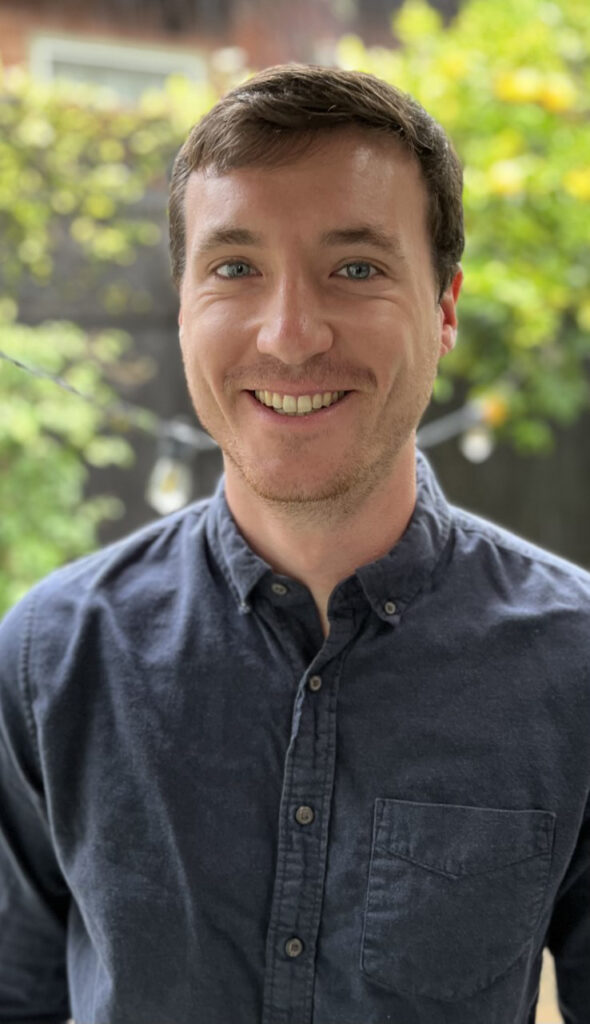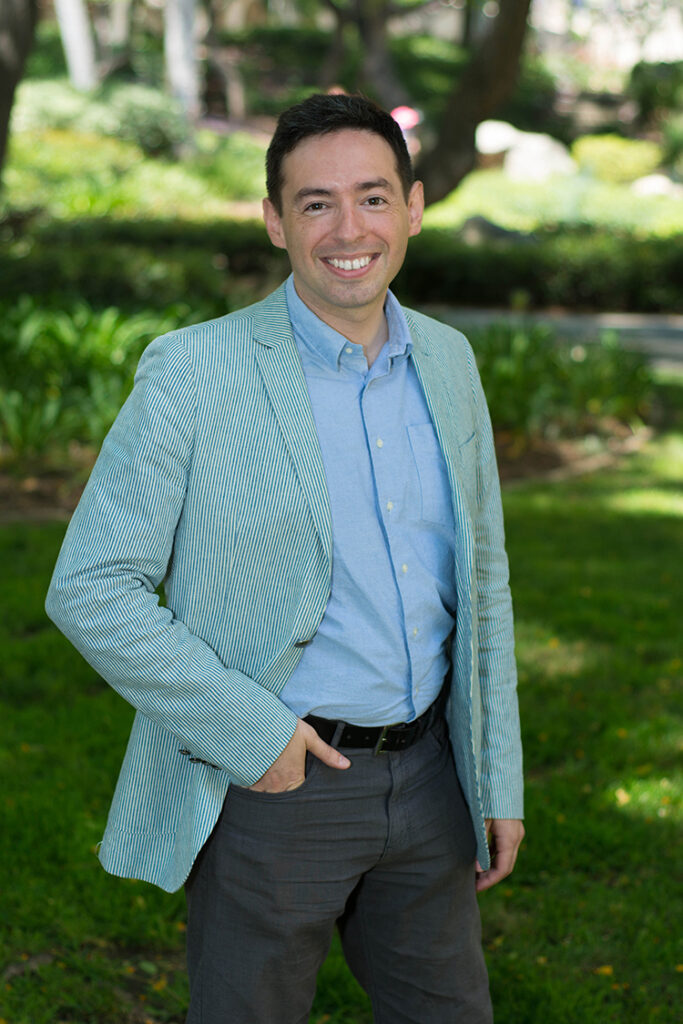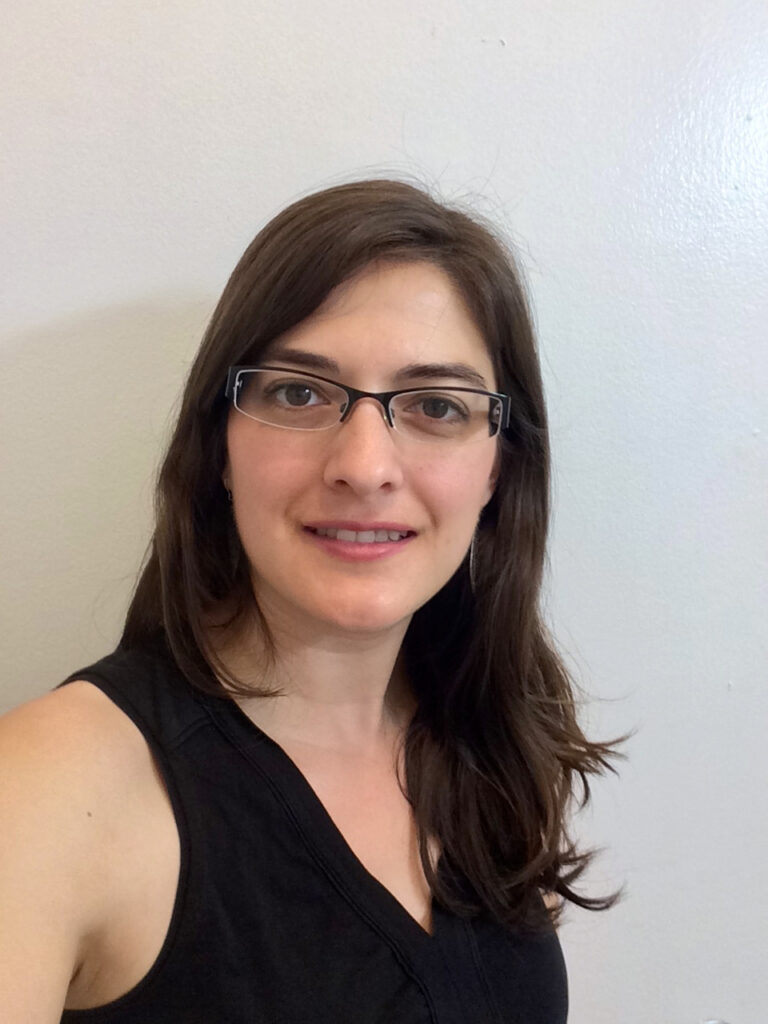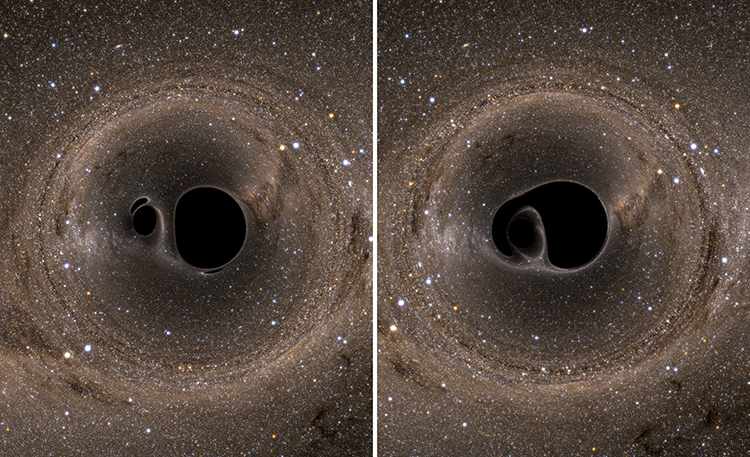
Computer renderings show two black holes about to merge as they spiral toward each other. The pair are shown from above (left) and from the side. To view a 'top view' video, go to https://www.youtube.com/watch?v=Zt8Z_uzG71o. For a 'side view' video, go to https://www.youtube.com/watch?v=ENd8Sz0AFOk. Images courtesy of the Simulating eXtreme Spacetimes Collaboration
University of Mississippi-led scientists discover nonlinear elements enhance computational models
Finding a needle in a haystack might prove easier than finding the most accurate measure of gravitational waves, telltale ripples in space-time created when massive black holes crash into each other. Yet a University of Mississippi physicist and his team have made significant advances in that direction.
Leo Chaim Stein, UM assistant professor of physics and astronomy, has been working with Keefe Mitman, a graduate student at the California Institute of Technology, and Macarena Lagos, a postdoctoral researcher at Columbia University, to precisely model gravitational waves that result from these cosmic collisions.
Stein, Mitman, and Lagos detail their findings in “Nonlinearities in black hole ringdowns,” an article published in the Feb. 15 edition of the journal Physical Review Letters. The article was selected as an “Editor’s suggestion,” a designation given to only about 15% of all papers and reserved for those that are “particularly important, interesting and well-written.”
“We want to mathematically model how black holes ‘ring down’ like a bell, because we can use the frequencies in the ringdown to test Einstein’s theory of gravity, general relativity,” Stein said.
UM is part of the Laser Interferometer Gravitational-Wave Observatory, or LIGO, Scientific Collaboration. The LIGO collaboration, working with the European-based Virgo interferometer, first detected gravitational waves in 2015 and have continued to study the phenomena.
When two black holes collide, they radiate more energy than all the stars in the universe for an instant, but astronomers have never directly observed one of these events with light. Instead, black hole mergers are observed through gravitational waves, ripples in space-time predicted by Einstein’s general theory of relativity, developed in 1915.
Such a merger results in a distorted “remnant” black hole that “rings down” like a struck bell as it relaxes into a simple one, emitting gravitational waves as it does so.
“We showed that the ringdown is more complicated than previously thought,” Stein said. “Specifically, that nonlinearities contribute new frequencies that weren’t considered before.”
Linearity is a powerful mathematical tool used by physicists to break up waveforms – such as music – into individual waves of different frequencies and amplitudes. Once that is done, they can deal with frequencies one at a time, without losing any information.
“If you have a sound system and speakers that are linear, then regardless of the volume of the music, they will reproduce the music perfectly,” Stein said. “But for real sound systems, when things get too loud, nonlinearities become important.
“Different frequencies start interfering with each other. That would lead to distorted sound.”
Stein continued the analogy with water waves.
“When looking at waves on the surface of water, very short waves just pass through each other as if the other wave wasn’t there, and the height of the surface is just the sum of the heights of the two individual waves,” he said. “But when waves get very tall, then they’ll start to break, and breaking waves are no longer mathematically described by just adding the heights of smaller waves.”
The same thing is true for the gravitational field – the small gravitational waves, or distortions in space-time.
“Waves at different frequencies will just pass through each other without getting altered at all,” Stein said. “But when nonlinearities are important, putting together two gravitational waves will now create a third gravitational wave at a different frequency we didn’t have before – much like the distortion in a sound system at very loud volumes.”
Properly modeling these ringdown waves is critical to proving that Einstein’s theory holds true, he said.
“Testing the theory means sleuthing into the minute details of the gravitational waves, to as many decimal places as possible,” Stein said. “We showed that to do this correctly requires modeling the nonlinear effects that we found.”
The synergy of Stein’s team is what allowed them to firm up this project, Lagos said.
“Keefe has experience and expertise on the development of high-accuracy binary black hole simulations, while I have the same on the theoretical aspects of the nonlinearities predicted by the theory of general relativity,” she said.
“I proposed the search of specific nonlinearities that were predicted to be the most relevant ones. Keefe performed the simulations and made the numerical search that confirmed their presence.”
The process involved taking 17 high-precision supercomputer simulations of merging black holes conducted by the Simulating eXtreme Spacetimes collaboration, of which UM is part, and analyzing them in a way that had not been done before.
“Firstly, we showed that these effects are present,” Stein said. “Secondly, we showed that including them in the model improved one metric of the quality of the model by a factor of approximately 100 times.
“Essentially, we found the ‘smoking gun’ of these nonlinear effects in the ringdown gravitational waves.”
Although the scientists know that there are indeed nonlinear effects present in the ringdown phase, they yet don’t know the extent of them.
“There may be more in our waveforms that we haven’t found yet,” he said. “And we don’t know if the same effects are in the waveforms that have been observed by LIGO, Virgo or KAGRA.”
Their results show that Stein, Mitman, and Lagos are on track to greatly improve analytical models of ringdown gravitational waves. This information is crucial to extract physical information from future detections.
“In addition, the confirmation and characterization of these nonlinearities suggest that they will be detectable in the future,” Lagos said. “This will allow us to better test the theory of general relativity in exotic environments, such as around black holes.”
The researchers will begin checking to see if they can find these same nonlinearities in the waveforms that the LIGO/Virgo detectors have observed, Mitman said.
“Because these effects are small and the accuracy of the detectors isn’t that high, they probably can’t be resolved in the observed waveforms,” he said. “However, another interesting study to look into is that we should be able to figure out by what date our detector accuracy will be high enough to see these nonlinear effects.”
“Our numerical simulations are much better modeled by including terms for nonlinear waves, rather than simply adding more linear modes,” Stein said.
As they celebrate their most recent achievement, the team understands that their work is far from over.
“(Basically, our work) confirmed that there is more work to do in correctly modeling the gravitational waves from ringdown,” Stein said. “Doing that modeling correctly is very hard, and the pencil-plus-paper theory hasn’t been developed enough yet for this.”
Luca Bombelli, chair and professor of the Ole Miss Department of Physics and Astronomy, said Stein’s paper reflects the high quality of the work being done in the department.
“Gravitational wave astrophysics is one of the research areas in which our department is especially strong,” Bombelli said. “Because of the presence of Dr. Stein, together with other faculty, postdocs and graduate students, we have one of the leading groups in the country.”
This material is based upon work supported by the National Science Foundation under grant No. 2047382. Other support came from The Sherman Fairchild Foundation and by NSF grants No. PHY-2011961, No. PHY-2011968 and No. OAC1931266 at Caltech; NSF grants No. PHY1912081, No. PHY-2207342 and No. OAC-1931280 at Cornell; The Innovative Theoretical Cosmology Fellowship, DOE DE-SC0011941, and a Simons Fellowship in Theoretical Physics at Columbia University; and NSF grant No. PHY-1759835 for supporting travel to a workshop where part of this work was conducted.
Stein also received a CAREER Award from the National Science Foundation in 2021 that has partially supported this work.
By Edwin B. Smith

